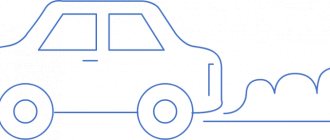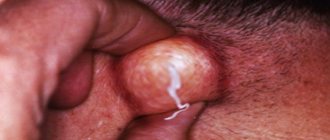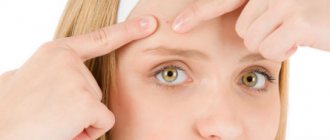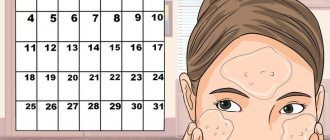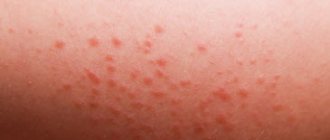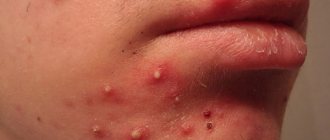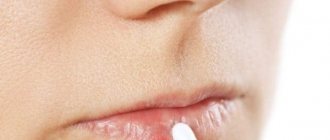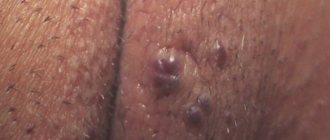Causes of carbuncle
The appearance of a carbuncle is preceded by an inflammatory process in the soft tissues, which usually begins with an inflammatory disease of the hair follicle - staphylococcal folliculitis, less often - with streptococcal folliculitis.
The development of inflammation can lead to the formation of a boil, which is an acute purulent-necrotic inflammation of the hair follicle. When several such boils form in one area of the body, they can merge with each other.
The product of the merger of several boils is a carbuncle. A sharp bursting pain occurs in the area of infiltration. The skin over the infiltrate becomes purple, tense, and swollen. Large amounts of gray-green pus are released from the pustules.
The tissues become necrotic. There are clear signs of general intoxication: tachycardia, nausea, vomiting, severe headache, hyperthermia up to 39-40 ° C, leukocytosis, shift of the blood count to the left, lack of appetite, insomnia. If the carbuncle is localized on the face, the symptoms of intoxication are much more pronounced, even to the point of fainting.
After exfoliation of necrotic tissue and removal of pus, the severity of signs of intoxication weakens significantly.
Risk factors for carbuncle formation:
- the presence of a chronic source of infection in the body;
- lack of vitamins;
- diabetes mellitus and other metabolic disorders;
- exhaustion of the body;
- psychological overload;
- immunodeficiency states;
- recent operations or serious illnesses;
- skin contamination, poor sanitary culture;
- nutritional deficiency;
- obesity;
- prolonged friction of the skin with clothing;
- increased sweating.
Carbuncle mainly affects teenagers and young adults. Men get sick more often than women.
Causes of acne on the temples in women
The skin on the temples is very delicate and thin, which makes it more vulnerable to bacteria. In addition, this part is carefully protected by the hair from external influences. This area takes a long time to recover from rashes, so you should not squeeze them out. Mostly the forehead and temples break out during the cold season. The main reason is wearing a hat, on which dirt accumulates and, under the influence of sebaceous fat, causes inflammation.
The main causes of the rash are independent of the season:
- gastrointestinal disorders;
- poor nutrition;
- clogged pores with cosmetics;
- hormonal imbalances.
And another common reason, not taken seriously, that causes acne near the hair is constant touching of the scalp with your hand. Hands have the most germs, which immediately multiply when they come into contact with vulnerable skin. Acne on the temples will appear during adolescence. This is due to the fact that the young body is going through puberty. Doctors say that the cause of the sudden rash may be a high intake of vitamins.
Pimples on the temples which organ is wrong
In both women and men, defects appear on the temples due to problems with the gallbladder and spleen. But if 1-2 pimples appear and not often, then you should not sin on your health. To be sure, you should visit not only a dermatologist, but also a therapist and a gastroenterologist. A heavily dusted face indicates the occurrence of diseases of the internal organs.
During pregnancy
A lot of pregnant women suffer from rashes on their faces. The disease can last for 9 months and ordinary ointments only slightly improve the appearance. The main cause of acne on the temples and face is unstable hormonal levels. Experts say that a pimple like a bump appears during pregnancy due to decreased immunity. The internal rash can last the entire period of breastfeeding.
Symptoms of carbuncle
Clinical signs of a carbuncle are:
- suppuration and wound formation;
- hyperemia of the skin around the lesion;
- severe pain in the entire affected area.
The appearance and development of a carbuncle is usually accompanied by the following symptoms:
- elevated temperature, which often reaches 40 degrees;
- major intoxication;
- vomiting;
- nausea;
- loss of appetite;
- headache;
- general malaise.
These signs are especially pronounced when the carbuncle appears on the face or neck.
There are 3 stages of carbuncle:
Stage 1: infiltrate (folliculitis)
During this period, nodes form under the skin, which will be represented by inflamed hair follicles. The infiltrate contains adipose tissue, pus, lymph and lymphocytes. Nodules rise above the surface of the skin.
Since the nutrition of the dermis is disrupted, it acquires a bluish color. After a few days (from 9 to 12), the infiltrate reaches impressive sizes. It can be about 10 cm in diameter. The skin is swollen, tense, and hot to the touch. The more swelling there is, the more intense the pain will be.
Stage 2: purulent formation
At the stage of suppuration, the carbuncle reaches maturity. Blisters form on it, which are filled with pus. They open, so the surface of the carbuncle resembles a sieve. Through these small holes, pus leaks out, mixed with blood and dead epithelium.
The suppuration stage lasts about 14-21 days. During this period, the patient’s general health deteriorates.
Stage 3: necrosis and tissue rejection
During this period, pus from the carbuncle stops oozing. At the site of inflammation, ulcers are formed that will have rods. They merge with each other, forming one large defect. Tissue damage is very intense and often involves muscles. The affected area is black.
The wound heals slowly, gradually filling with granulations. A scar remains in its place. The necrosis stage lasts about 21 days.
Pimples on temples how to get rid of
It is worth noting that acne in the temple area takes a long time to disappear, unlike on the forehead and cheeks. In addition, treatment with one remedy does not always help. External causes in women are eliminated by natural creams and ointments, as well as herbal lotions.
Garnier brand products provide effective treatment for infrequent rashes. Many women struggle with various types of rashes with mechanical facial cleansing. The skin becomes cleaner, but there is a risk of spreading infection.
You can use the traditional method of sea salt and sour cream. 1 tbsp. l. combine salt with 3 tbsp. l. sour cream with a high percentage of fat content. Apply with massage movements to the problem area of the skin, then rinse. Such masks show effective results in combination with various scrubs.
Subcutaneous acne
The appearance of a subcutaneous rash is a rather unpleasant and painful manifestation. Before starting treatment, you need to find out what the psychosomatics of the disease is. If it is related to hormones, then you will have to use hormonal ointments. If the seals are caused by pathogenic microflora, then try zinc, salicylic and ozone ointments. Barizon and Zenerit work well. When the use of ointments is unacceptable for women, then wipe your face with a decoction of celandine, chamomile, nettle and string. The affected area can also be treated with saline solution.
Purulent
Purulent acne on the temples mainly occurs due to the ingress of harmful microorganisms.
Treatment of purulent acne should be extremely careful. The doctor may prescribe the following external remedies:
- Ichthyol;
- Vishnevsky ointment;
- Dalatsin;
- Skinoren;
- Levomikol.
One large abscess in women, whether on the temples or forehead, can remove iodine. It is applied pointwise until the abscess completely disappears. As soon as redness begins to appear, you can treat it with peroxide. This is also a good method, but not as fast-acting.
Any rash on the body and face is removed by aloe. Treatment is carried out as follows: the leaf is cut and the pulp is applied to the abscess, secured with a plaster. It's better to do this at night. The pimple will go away in a few days. Aloe works better than Ichthyol and Vishnevsky ointment. If painful redness begins to appear, burn it with calendula tincture.
Watery
Watery pimples on the temples and forehead in women appear more often in hot weather. And the reason for this is excessive secretion of sweat and sebum. It's easy to remove them.
You can use medications to help:
- Chlorhexidine;
- Skinorin;
- Rescuer.
Most women who have experienced the problem of a rash on their temples recommend first cleansing the body from the inside. Scrubbing several times a week will cleanse the skin of dead cells and allow the skin to better transmit oxygen. These are the main points of any care.
Methods for diagnosing carbuncle
Carbuncle is diagnosed based on clinical symptoms.
Differential diagnosis is carried out with the following pathologies:
- rupture of an epidermal cyst;
- hidradenitis (if the carbuncle is localized in the perineum or armpit);
- anthrax;
- chronic ulcerative herpes.
Laboratory diagnostics
Microscopy of the smear reveals staphylococci. Bacterial culture allows identification of the pathogen and assessment of sensitivity to antibiotics.
Sign up for diagnostics To accurately diagnose the disease, make an appointment with specialists from the Family Doctor network.
Treatment methods for carbuncle
Small carbuncles that occur without noticeable intoxication and deterioration of the patient’s general condition are treated on an outpatient basis.
In cases where
- the patient is severely intoxicated,
- the carbuncle is large and localized on the face,
- the patient suffers from uncompensated diabetes mellitus or other serious diseases,
treatment is carried out in a hospital.
Conservative treatment
If treatment of the carbuncle was started at the stage of its maturation, then conservative methods are used, which in most cases leads to regression of the disease, that is, resorption of the infiltrate.
Antibacterial drugs with a broad spectrum of action are indicated for oral administration to the patient.
At the same time, the carbuncle itself is injected with antibiotics. To reduce pain, analgesics (Novocaine, Lidocaine) are used.
The surface of the carbuncle is treated with ethyl alcohol or other alcohol-containing antiseptics. An aseptic dressing is applied. Syntomycin or streptomycin emulsions are also used.
Surgery
If the carbuncle enters the necrotic stage, then this is an indication for surgery, which is performed while using antibiotic therapy.
The operation consists of dissecting the carbuncle and removing necrotic tissue from it.
Then a tampon with a hypertonic sodium chloride solution and proteolytic enzymes is inserted into the wound.
To clean the postoperative wound and completely remove necrotic tissue, the dressing is changed daily.
Physiotherapy
At the maturation stage, as well as in the postoperative period, UHF therapy and local ultraviolet radiation are prescribed.
To stimulate the body's defenses, intravenous laser and ultraviolet irradiation of blood can also be performed.
More information about the treatment method
Make an appointment Do not self-medicate. Contact our specialists who will correctly diagnose and prescribe treatment.
Rate how useful the material was
thank you for rating
How to relieve inflammation of a pimple* on the face?
You can relieve inflammation from a pimple* only if you use medications designed for this purpose. Many people make mistakes by using iodine and alcohol (including alcohol tinctures), but this only increases peeling of the skin, causing even greater blockage of the mouths of the follicles.
It would also be a mistake to use folk recipes, for example, applying soda masks to your face or wiping the skin with vinegar, so you will not only not be able to remove redness and inflammation, but will also create new ones.
In the treatment of acne, it is necessary to use drugs with keratolytic, antibacterial, anti-inflammatory, and sebum-regulating effects. Depending on the severity of the disease, topical, systemic drugs, or a combination of both may be prescribed.
Clindovit® gel is used to treat mild to moderate acne 6,18. It must be used 2-3 times a day 6.
A specialist must make a diagnosis and prescribe treatment. Non-drug methods can be used as auxiliary therapy, for example, laser therapy, mesotherapy, peelings, plasma therapy, etc. But they are contraindicated in active inflammatory processes. Only after the inflammation has been relieved can you resort to cosmetic procedures.

